On this Day in History ... 29th August
29 Aug is in August.
1156 Henry II and Eleanor of Aquitaine Reunited
1613 Thomas Overbury Murder and Trial of his Murderers
Events on the 29th August
Before 29 Aug 1156 King Henry "Curtmantle" II of England (age 23) and Eleanor of Aquitaine Queen Consort Franks and England (age 34) were reunited in Saumur [Map].
On 29 Aug 1189 King John "Lackland" of England (age 22) and Isabella Fitzrobert 3rd Countess Gloucester and Essex (age 16) were married at Marlborough Castle [Map]. He by marriage Earl Gloucester. She the daughter of William Fitzrobert 2nd Earl Gloucester and Hawise Beaumont Countess Gloucester. He the son of King Henry "Curtmantle" II of England and Eleanor of Aquitaine Queen Consort Franks and England (age 67). They were half second cousins. She a great granddaughter of King Henry I "Beauclerc" England. 


Liber de Antiquis Legibus 1255. 29 Aug 1255. After this, on the Sunday before the Decollation of Saint John [29 August] the King of Scotland (age 13) and his Queen (age 14) came to London, the City being decorated and hung with tapestry.

On 29 Aug 1350 the English fleet defeated a Castilian fleet at Winchelsea [Map] during the Battle of Winchelsea. Around twenty Castilian ships were captured; several were sunk. For the English King Edward III of England (age 37) and his son Edward "Black Prince" (age 20), James Audley (age 32), Henry Scrope 1st Baron Scrope Masham (age 37), Henry of Grosmont 1st Duke Lancaster (age 40) and John Sully (age 67) fought.



Chronicle of Gregory 1437. 29 Aug 1437. Ande the same year the Erle of Warwyke (age 55) went into Fraunce the xxix day of Auguste; he schippyd at Portysmouthe, and the Duke of Yorke (age 25) come home into Ingelonde out of Fraunce.
On 29 Aug 1475 Edward IV (age 33) signed the Treaty of Picquigny; in effect a non-aggression pact or, possibly, a protection racket. France would pay Edward a pension of 50,000 crowns per year as long as he didn't invade France. Cardinal Bourchier (age 57) arbitrated on behalf of Edward. William Hastings (age 44) received a pension of 2000 crowns per year, John Howard and Thomas Montgomery 1200 each, Thomas Rotherham Archbishop of York (age 52) 1000, Cardinal John Morton (age 55) 600.



Edward's youngest brother Richard (age 22) opposed the Treaty considering it dishonourable. Roger Cheney (age 33) was present at the signing, and remained as a hostage until King Edward IV of England (age 33) returned to England.
Henry Machyn's Diary. 29 Aug 1555. The same day the Kyng('s) (age 28) grace toke ys jorney toward Dover, Kent [Map], and with a grett compeny, and ther tared for the wynd, and ther the shypes lying rede [ready] for ys grace gohyng over see.
Note. P. 93. Departure of king Philip. The king crossed to Calais on the 4th Sept. "and so foorth to Brusselles in Brabant to visite the emperour hys father." (Stowe's Summarie, 1566.) He went to assume the government of the Low Countries, and was received into Antwerp with great solemnity about the 18th January. (Ibid.)
On 29 Aug 1571 Norfolk's secretaries William Barker and Robert Higford entrusted to Thomas Browne, a Shrewsbury draper, what was purported to be a bag of silver coin for delivery to Laurence Bannister, one of Norfolk's officials in the north of England. Browne grew suspicious of the bag's weight, opened it, and discovered 600 pounds in gold from the French ambassador, destined for Scotland on Mary's behalf, and ciphered letters. Because he knew Norfolk was under suspicion, Browne reported his find to William Cecil 1st Baron Burghley (age 50), the Secretary of State. Higford and Barker were interrogated, the letters were partly deciphered, and a search for the cipher key at Howard House uncovered a ciphered letter from Mary Stuart hidden under a doormat. 
On 29 Aug 1582 Thomas St Paul died. He was buried at St Lawrence's Church, Snarford [Map]. Monument to Thomas St Paul and Faith Grantham. Fine freestanding tomb chest with canopy. The sides of the tomb chest have acanthus Pilasters, the panels between contain wreathed shields. The full length recumbent albaster effigies show the man in full plate armour holding sword and prayerbook, head on helm, feet on a cushion with flowers. His wife is in a long dress with cloak and close fitting hat, holding a bible. The inscription runs round the top edge of the chest. The canopy is supported on six pillars, those at the angles being circular and bulbous, the others in the form of obelisks decorated with fishscale Paterae, with elaborate Ionic Capitals with roses in the necking. The entablature has an egg and dart frieze. Above the heads of the columns are five female and one male weepers. At the centre of the canopy is a raised altar bearing shields and surmounted by the kneeling figure of the heir clad in armour. In front kneels a larger figure of a girl. the monument is all painted and gilded.
Thomas St Paul: he was appointed High Sheriff of Lincolnshire. he and Faith Grantham were married. In 1580 Thomas St Paul was knighted by Queen Elizabeth I of England and Ireland at Richmond, Surrey.
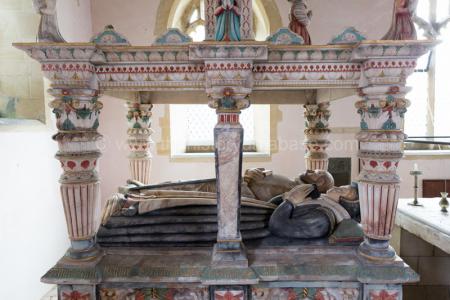
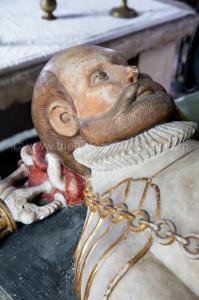

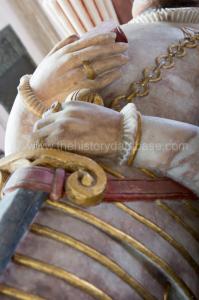
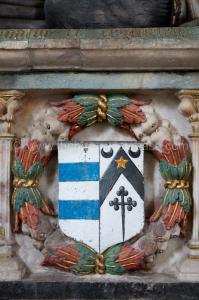
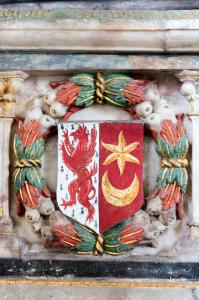
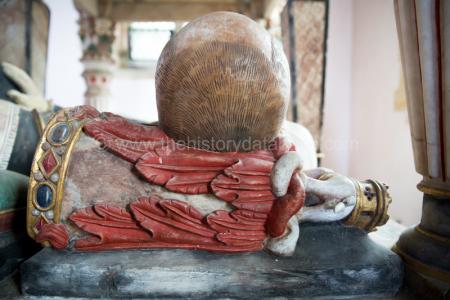
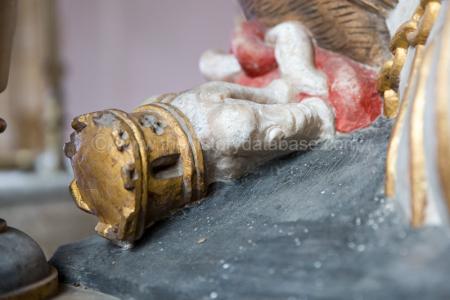
On 29 Aug 1597 Henry Gage was born to John Gage (age 34) and Margaret Copley (age 65) at Haling, Surrey.
After 29 Aug 1611. Monument to Letice Clifford (deceased) at All Saints Church, Barnwell [Map].
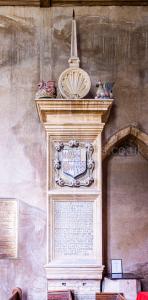
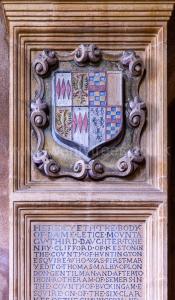
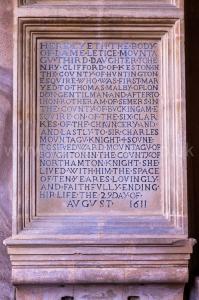
Letters of the Court of James I 1613 Reverend Thomas Lorkin to Sir Thomas Puckering Baronet 29 Aug 1613. 29 Aug 1613. London. Reverend Thomas Lorkin to Thomas Puckering 1st Baronet (age 21).
Yoa may please to remember how, in some of my former letters, I made mention of my Lord of Essex's (age 22) case, which was to rest in dependance till next term. But the king showed himself so affectionate in it, as the commissioners have been forced (to give his majesty satisfaction) to yield a more speedy hearing of it, which was done (though with little effect) upon last Wednesday. But it is believed generally that unless the commission be changed, the nullities which his majesty desireth will never be pronounced. For the Archbishop of Canterbury (age 50) and the Bishop of London (age 54), together with Dr. Bennet, and Dr. Edwards, who are like to have the greatest sway in deciding this controversy, are directly against it; insomuch as my Lord of Canterbury (age 50), being with his majesty at Windsor for some three or four days before the hearing, fell down upon his knees twice or thrice, to entreat his majesty that he might be dispensed with from being on the commission; which he would esteem a greater favour that all that he had received from him in being raised from a private condition, and in so short a space, to the highest dignity ecclesiastical. At the last hearing, my Lord of Rochester (age 26) stayed here in town, as is supposed, to hear the success, and rode presently past unto the king, [to acquaint] his majesty thereof, and showeth himself so passionate in this business only in favour [of the countess (age 23),] with whom a new match would be presently concluded, if the old one were now abolished.


Sir Thomas Overbury (age 32) is like to run a short course, being sick unto death1. The lieutenant of the Tower, and the physicians that were there about him, have subscribed their hands, that they hold him a man past all recovery.
Mr. Albert Morton (age 29), secretary of Sir Henry Wotton, is to be sent presently ambassador to the Duke of Savoy (age 51), and there [remain], which gives occasion of conjecture here that the old treaty of marriage is now [on foot] again; and that that other of France is like to fall to the ground. But in these [conjectures] haply it would be fit to be more sparing.
I received news lately from a gentleman, that heard it from Sir Ralph Winwood's (age 50) own mouth, that the States are resolved to make war upon the King of Denmark, if either our king will join them, or otherwise be [persuaded] to stand by a neuter. Their quarrel is, for that the King of Denmark hath imposed a grievous tax upon all merchandize that pass the Sound, and he hath in effect blocked up that passage: for it is held that of every three ships that pass, one falls by this means to his share, which is a thing intolerable.
The differences between them of the Religion in France are grown so violent as the deputies'-general have petitioned the queen, in the name of all the provinces, for liberty to hold a general assembly for [consideration] and pacification of them. But they find this request to be nothing pleasing, nor without great difficulty to be ob- tained, out of a jealousy the States hath that they may grow to new complaints and demands, after the example of the last assembly.
There hath been lately a proposition of marriage between the daughter of M. D'Ancre, and M. De Villeroy's grand-child, who is the heir of his house; there having been a former intention of matching her with the young Duke D'Elboeuf, which gives occasion of great jealousy and suspicion to M. De Guise and his faction, fearing by this news that M. De Yilleroy will be disjoined from them.
Note 1. He died on the 15th of September following, from poison, which Rochester and his countess had caused to be administered in his food.
On 29 Aug 1660 the Indemnity and Oblivion Act became law. The act was a general pardon for everyone who had committed crimes during the Civil War and Interregnum with the exception of certain crimes such as murder (without a licence granted by King or Parliament), piracy, buggery, rape and witchcraft, and people named in the act such as those involved in the regicide of Charles I.
Henry Mildmay (age 67) was excepted from the Indemnity and Oblivion Act.
James Harington 3rd Baronet (age 52) was exempted. In 1661 his Baronetcy was forfeit for life.
Evelyn's Diary. 29 Aug 1662. The Council and Fellows of the Royal Society went in a body to Whitehall [Map], to acknowledge his Majesty's (age 32) royal grace in granting our Charter, and vouchsafing to be himself our founder; when the President made an eloquent speech, to which his Majesty (age 32) gave a gracious reply and we all kissed his hand. Next day we went in like manner with our address to my Lord Chancellor (age 53), who had much promoted our patent: he received us with extraordinary favor. In the evening I went to the Queen-Mother's (age 52) Court, and had much discourse with her.

On 29 Aug 1700 John Cecil 5th Earl Exeter (age 52) died. His son John Cecil 6th Earl Exeter (age 26) succeeded 6th Earl Exeter, 7th Baron Burghley. Elizabeth Brownlow Countess Exeter (age 19) by marriage Countess Exeter.

He was buried at St Martin's Church, Stamford [Map]. Monument to John Cecil and his wife Anne Cavendish Countess Exeter (age 51) sculpted by the French sculptor Pierre Etienne Monnot (age 43) who was working in Rome. Neo-classical statuary group. One of the finest tombs of its day in the country, displaying strong antique tendencies as befits its Roman creation.
John Cecil 5th Earl Exeter:
Around 1648 he was born to John Cecil 4th Earl Exeter and Frances Manners Countess Exeter.
On 02 May 1670 John Cecil 5th Earl Exeter and Anne Cavendish Countess Exeter were married. She the daughter of William Cavendish 3rd Earl Devonshire and Elizabeth Cecil Countess Devonshire. He the son of John Cecil 4th Earl Exeter and Frances Manners Countess Exeter. They were half third cousin once removed.

 In Feb 1678 John Cecil 4th Earl Exeter died. His son John Cecil 5th Earl Exeter succeeded 5th Earl Exeter, 6th Baron Burghley. Anne Cavendish Countess Exeter by marriage Countess Exeter.
In Feb 1678 John Cecil 4th Earl Exeter died. His son John Cecil 5th Earl Exeter succeeded 5th Earl Exeter, 6th Baron Burghley. Anne Cavendish Countess Exeter by marriage Countess Exeter.
Elizabeth Brownlow Countess Exeter:
In 1681 she was born to John Brownlow 3rd Baronet and Alice Sherard Baroness Brownlow.
In 1699 John Cecil 6th Earl Exeter and she were married. He the son of John Cecil 5th Earl Exeter and Anne Cavendish Countess Exeter.
In 1710 Margaret Brownlow died of smallpox. Her estate of £40,000 was divided between her four sisters: Jane Brownlow Duchess Ancaster and Kesteven, Elizabeth Brownlow Countess Exeter, Alicia Brownlow Baroness Guildford and Eleanor Brownlow Viscountess Tyconnel. In 1723 Elizabeth Brownlow Countess Exeter died.
In 1723 Elizabeth Brownlow Countess Exeter died.
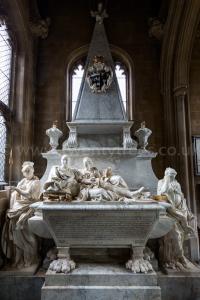
On 29 Aug 1718 John Cust 3rd Baronet was born to Richard Cust 2nd Baronet (age 37) and Anne Brownlow Lady Cust (age 24).
On 29 Aug 1744 Adolph Frederick King Sweden (age 34) and Louisa Ulrika of Prussia Queen Consort of Sweden (age 24) were married. She the daughter of Frederick William "Soldier King" I King Prussia and Sophia Dorothea Hanover Queen Consort Prussia (age 57). She a granddaughter of King George I of Great Britain and Ireland. 
On 29 Aug 1785 Harriet Cavendish Countess Granville was born to William Cavendish 5th Duke Devonshire (age 37) and Georgiana Spencer Duchess Devonshire (age 28) at Devonshire House [Map].

On 29 Aug 1797 Joseph Wright of Derby (age 62) died at his home 28 Queen Street, Derby [Map].
On 29 Aug 1816 John Arthur Fane died. He was buried in the Church of St Leonard, Apethorpe [Map]. White marble effigy of infant in bonnet, on mattress and couch decorated with anthemion ornament
John Arthur Fane:
On 12 Feb 1816 he was born to John Fane 11th Earl of Westmoreland and Priscilla Anne Wellesley-Pole Countess of Westmoreland.
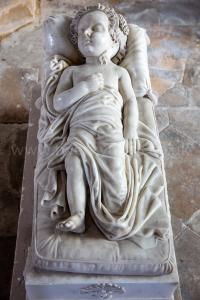
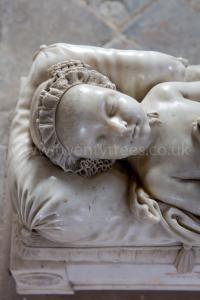
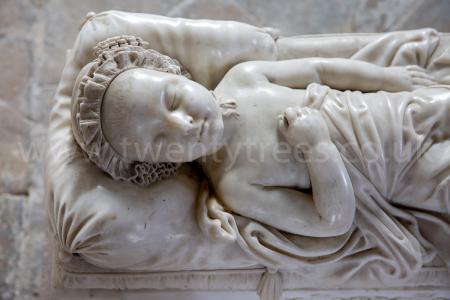
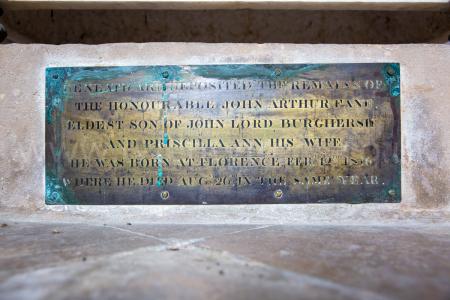
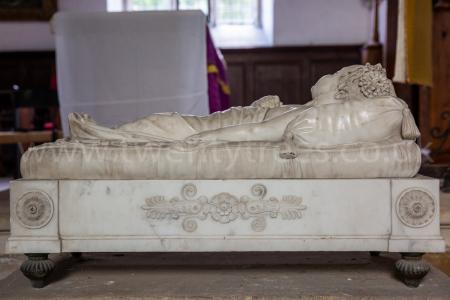
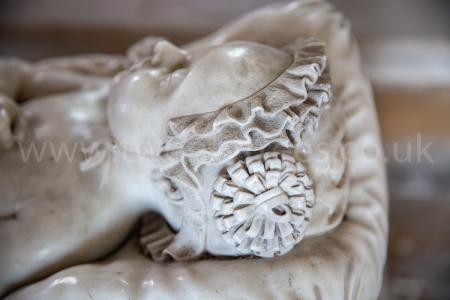
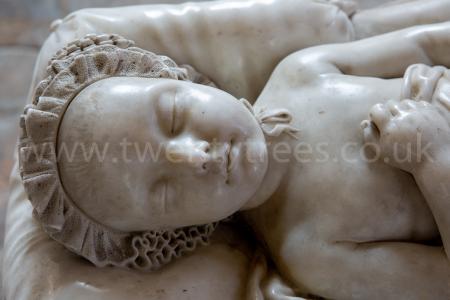
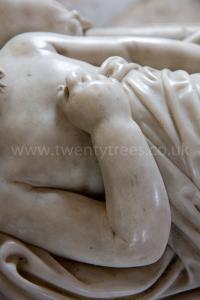
On 29 Aug 1839 Reverend Bourchier William Wrey (deceased) was buried at St Peter's Church, Tawstock [Map]. Inscrption: In memory of the Revd BOURCHIER WILLIAM WREY, M.A. Son of Sir BOURCHIER WREY, Bar; and 38 Years Rector of this Parish, who departed this Life, and entered into his Eternal Rest Augst 19th, 1839, Aged 78 Years. Here Affection lingers to recal his noble mien, his gentle dignified address, his amiability, benevolence, and worth, and Piety, with humble thankfulness records, the heavenborn comfort of his latter years, wherein the Name of Jesus proved, his Wisdom, Righteousness and Strength, his Joy in sorrow, his Life in death. Also in memory of SOPHIA (age 72) Wife of the above Br Wm WREY who departed this Life Decr 1st 1848; Aged 81 Years. Blessed are the Dead which Die in the Lord."
Sophia Bethell: Around 1767 she was born to George Bethell. In 1789 Reverend Bourchier William Wrey and she were married. On 01 Dec 1848 she died.
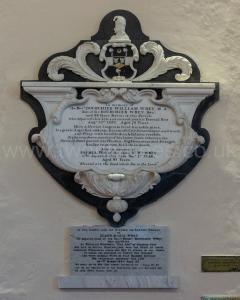
On 29 Aug 1842 The Treaty of Nanking signed aboard Cornwallis. The peace treaty that concluded the First Opium War. The Chinese regarded it as an 'Unequal Treaty'; the British fleet were anchored in Nanking poised to attack. The treaty required the Chinese to pay the British six million silver dollars for the opium that had been confiscated by Lin Zexu in 1839 (Article IV), 3 million dollars in compensation for debts that the Hong merchants in Canton owed British merchants (Article V), and a further 12 million dollars in war reparations for the cost of the war (Article VI). The total sum of 21 million dollars was to be paid in instalments over three years and the Qing government would be charged an annual interest rate of 5 percent for the money that was not paid in a timely manner (Article VII) (See Wikipedia).
On 29 Aug 1863 George Wyndham was born to Percy Scawen Wyndham (age 28) and Madeline Caroline Frances Eden Campbell.
Births on the 29th August
On 29 Aug 979 Otto Vermandois I Count Vermandois was born to Herbert Vermandois III Count Vermandois (age 26) and Ermengard of Bar Countess Vermandois (age 33).
On 29 Aug 1116 Philip Capet was born to Louis "Fat" VI King France (age 34) and Adelaide Savoy Queen Consort France.
On 29 Aug 1321 John "Sans Terre" Artois 1st Count Eu was born to Robert III Artois (age 34) and Joan Valois Countess Zeeland Holland Avesnes and Hainault (age 27). He a great x 2 grandson of King Henry III of England. Coefficient of inbreeding 1.98%. 
On 29 Aug 1347 John Hastings 2nd Earl Pembroke was born to Laurence Hastings 1st Earl Pembroke (age 28) and Agnes Mortimer Countess of Pembroke (age 30) at Sutton Valence, Maidstone.

On 29 Aug 1419 James Pickering was born to James Pickering (age 23).
After 29 Aug 1428 Radegonde Valois was born to Charles "Victorious" VII King France (age 25) and Marie Valois Anjou Queen Consort France (age 23). Coefficient of inbreeding 3.89%. 
After 29 Aug 1428 Catherine Valois was born to Charles "Victorious" VII King France (age 25) and Marie Valois Anjou Queen Consort France (age 23). Coefficient of inbreeding 3.89%. 
Around 29 Aug 1429 John Boteler was born to John Boteler of Bewsey (age 27) and Isabel Harrington (age 23).
On 29 Aug 1578 Elizabeth Isham was born to Thomas Isham of Langport in Northamptonshire (age 22).
On 29 Aug 1588 Francis Howard was born to William Howard (age 24) and Elizabeth Dacre (age 23) at Naworth Castle [Map].

On 29 Aug 1595 Joachim Ernest Oldenburg was born to John "Younger" Oldenburg Duke Schleswig Holstein Sonderburg (age 50) and Agnes Hedwig of Anhalt (age 22).
On 29 Aug 1597 Henry Gage was born to John Gage (age 34) and Margaret Copley (age 65) at Haling, Surrey.
On 29 Aug 1600 John Stawell was born to John Stawell of Cothelstone Manor and Elizabeth Tuchet.
On 29 Aug 1627 Vere Herbert was born to Henry Herbert (age 33).
On 29 Aug 1628 John Granville 1st Earl Bath was born to Bevil Grenville (age 33) and Grace Smith.
On 29 Aug 1632 John Locke was born.
On 29 Aug 1686 Penelope Dashwood was born to Robert Dashwood 1st Baronet (age 23) and Penelope Chamberlayne Lady Dashwood (age 23).
On 29 Aug 1694 Elizabeth Hesketh Countess Derby was born to Robert Hesketh (age 24).
On 29 Aug 1718 John Cust 3rd Baronet was born to Richard Cust 2nd Baronet (age 37) and Anne Brownlow Lady Cust (age 24).
On 29 Aug 1723 Francis Henry Drake 5th Baronet was born to Francis Drake 4th Baronet (age 29) and Anne Heathcote Lady Drake (age 21).
On 29 Aug 1725 Andrew Thomas Stewart 1st Earl Castle Stewart was born to Robert Stewart 8th Baron Castle Stuart (age 25).
On 29 Aug 1729 David La Touche was born to David La Touche (age 25).
On 29 Aug 1742 Anne Howard was born to Philip Howard (age 54) and Henrietta Blount.

On 29 Aug 1745 William Clive was born to Richard Clive (age 51) and Rebecca Gaskell at The Styche, Market Drayton.
On 29 Aug 1750 William Henry Irby was born to William Irby 1st Baron Boston (age 43) and Albania Selwyn Baroness Boston (age 31).
Before 29 Aug 1751 Anne Manners was born illegitimately to John Manners Marquess of Granby (age 30).
On 29 Aug 1751 John Manners was born to John Manners Marquess of Granby (age 30) and Frances Seymour (age 23).

On 29 Aug 1753 Mary Leslie Countess Portmore was born to John Leslie 10th Earl Rothes (age 55) and Hannah Cole Countess Rothes.
On 29 Aug 1765 Caroline Yorke Countess St Germans was born to Charles Yorke (age 42) and Agneta Johnson (age 24).
On 29 Aug 1775 Emily Baring was born to Charles Baring (age 32) and Margaret Gould (age 32).
On 29 Aug 1780 Isabella Pilkington was born to Michael Pilkington 6th Baronet (age 65).
On 29 Aug 1782 John James Stuart was born to Charles Stuart (age 29) and Anne Louisa Bertie.

On 29 Aug 1785 Harriet Cavendish Countess Granville was born to William Cavendish 5th Duke Devonshire (age 37) and Georgiana Spencer Duchess Devonshire (age 28) at Devonshire House [Map].

On 29 Aug 1787 Edward William Waldegrave was born to George Waldegrave 4th Earl Waldegrave (age 35) and Elizabeth Laura Waldegrave Countess Waldegrave (age 27). He a great x 3 grandson of King James II of England Scotland and Ireland. Coefficient of inbreeding 6.27%. 
On 29 Aug 1790 Leopold Grand Duke of Baden was born.
On 29 Aug 1792 Mary Wyndham Countess Munster was born illegitimately to George O'Brien Wyndham 3rd Earl Egremont (age 40) and Elizabeth Ilive Countess Egremont (age 23).
On 29 Aug 1797 George Robinson 7th Baronet was born to William Villiers Robinson (age 30).
On 29 Aug 1798 Edward Granville Eliot 3rd Earl St Germans was born to William Eliot 2nd Earl St Germans (age 31) and Georgiana Augusta Leveson-Gower (age 29) at Plymouth, Devon [Map].
On 29 Aug 1800 Georgina Paget Lady Crofton was born to Henry William Paget 1st Marquess Anglesey (age 32) and Caroline Elizabeth Villiers Duchess Argyll (age 25).

On 29 Aug 1802 Mathew Wilson 1st Baronet was born to Mathew Wilson of Eshton Hall (age 30) and Margaret Clive Wilson (age 38). Coefficient of inbreeding 3.12%.
On 29 Aug 1822 Thomas Fowell Buxton was born to Thomas Fowell Buxton 1st Baronet (age 36) and Hannah Gurney Lady Buxton (age 39).
On 29 Aug 1823 Charles Cornwallis Neville 5th Baron Braybrooke was born to Richard Griffin 3rd Baron Braybrook (age 39) and Jane Cornwallis Baroness Braybrook (age 24).
On 29 Aug 1829 Leveson Eliot Henry Somerset was born to Granville Charles Henry Somerset (age 36) and Emily Smith.
On 29 Aug 1829 James Hay Erskine-Wemyss was born to Rear-Admiral James Erskine-Wemyss (age 40) and Emma Hay.
On 29 Aug 1834 Malcolm Murray-MacGregor 4th Baronet was born.
On 29 Aug 1834 Jane Louisa Octavia Grosvenor was born to Richard Grosvenor 2nd Marquess Westminster (age 39) and Elizabeth Mary Leveson-Gower Marchioness Westminster (age 37).
On 29 Aug 1835 Ivor Bertie Guest was born to John Josiah Guest 1st Baronet (age 50) and Charlotte Elizabeth Bertie (age 23).
On 29 Aug 1846 Constantine Phipps 3rd Marquess Normanby was born to George Phipps 2nd Marquess Normanby (age 27) and Laura Russell Marchioness Normanby (age 30). He was educated at the University of Durham.
On 29 Aug 1860 Henry Edward Paston-Bedingfeld 8th Baronet was born to Henry George Paston-Bedingfeld 7th Baronet (age 30) and Augusta Lucy Clavering Lady Paston-Bedingfield.
On 29 Aug 1863 George Wyndham was born to Percy Scawen Wyndham (age 28) and Madeline Caroline Frances Eden Campbell.
On 29 Aug 1864 Hilda Mary Keppel was born to William Keppel 7th Earl Albermarle (age 32) and Sophia Mary MacNab of Dundurn Castle (age 32).
On 29 Aug 1865 Walter Erskine 12th Earl of Mar and 14th Earl of Kellie was born.
On 29 Aug 1865 Kate m Trotter was born.
On 29 Aug 1869 Stafford Harry Northcote was born to Walter Stafford Northcote 2nd Earl Iddesleigh (age 24) and Elizabeth Lucy Meysey-Thompson (age 25).
On 29 Aug 1873 Major Chandos Leigh was born to Edward Chandos Leigh (age 40).
On 29 Aug 1885 Cynthia Rachael Lascelles was born to Gerald William Lascelles (age 35) and Constance Augusta Mary FitzClarence Phillipson (age 34).
On 29 Aug 1888 George Sutherland-Leveson-Gower 5th Duke of Sutherland was born to Cromartie Sutherland-Leveson-Gower 4th Duke of Sutherland (age 37) and Millicent Fanny St Clair-Erskine Duchess of Sutherland (age 20).
On 29 Aug 1897 Gerald Howard-Boteler Irby 9th Baron Boston was born to Lieutenant-Colonel Leonard Paul Irby (age 26).
On 29 Aug 1898 Lewis Charles Bagot Chester was born to Reverend John Greville Chester (age 36) and Amelia Kate Hughes.
On 29 Aug 1905 Commander John Montagu Granville Waldegrave was born to Montague Waldegrave 5th Baron Radstock (age 38).
On 29 Aug 1932 Geoffrey Somerset 6th Baron Raglan was born to Fitzroy Somerset 4th Baron Raglan (age 47) and Julia Somerset Baroness Raglan (age 31).
On 29 Aug 1948 George Child-Villiers Viscount Villiers was born to George Child-Villiers 9th Earl of Jersey (age 38).
Marriages on the 29th August
On 29 Aug 1189 King John "Lackland" of England (age 22) and Isabella Fitzrobert 3rd Countess Gloucester and Essex (age 16) were married at Marlborough Castle [Map]. He by marriage Earl Gloucester. She the daughter of William Fitzrobert 2nd Earl Gloucester and Hawise Beaumont Countess Gloucester. He the son of King Henry "Curtmantle" II of England and Eleanor of Aquitaine Queen Consort Franks and England (age 67). They were half second cousins. She a great granddaughter of King Henry I "Beauclerc" England. 


Before 29 Aug 1320 Robert Welles 2nd Baron Welles (age 24) and Maud Clare Baroness Clifford Baroness Welles (age 44) were married. She by marriage Baroness Welles. The difference in their ages was 20 years; she, unusually, being older than him. She a great x 3 granddaughter of King Henry "Curtmantle" II of England. 

Before 29 Aug 1338 Edward Montagu 1st Baron Montagu and Alice Plantagenet (age 14) were married. She the daughter of Thomas of Brotherton 1st Earl Norfolk (deceased) and Alice Hales Countess Norfolk. She a granddaughter of King Edward "Longshanks" I of England. 

Before 29 Aug 1429 John Boteler of Bewsey (age 27) and Isabel Harrington (age 23) were married.
On 29 Aug 1442 Arthur Montfort III Duke Brittany (age 49) and Jeanne Albret were married at Nérac. He the son of John Montfort V Duke Brittany and Joanna of Navarre Queen Consort England. They were second cousin once removed. He a great x 3 grandson of King Henry III of England. 
On 29 Aug 1454 Henry Grey 4th or 7th Baron Grey of Codnor (age 19) and Katherine Strangeways Baroness Grey Codnor were married. She by marriage Baroness Grey of Codnor. She the daughter of Thomas Strangeways and Katherine Neville Duchess Norfolk (age 54). They were third cousin once removed. She a great x 2 granddaughter of King Edward III of England. 


After 29 Aug 1464 Peter Luxemburg II Count Saint Pol and Soissons (age 24) and Margaret Savoy Countess Saint Pol (age 25) were married. She the daughter of Louis Savoy I Count Savoy (age 51) and Anne Cyprus Countess Savoy. He the son of Louis Luxemburg I Count Saint Pol (age 46) and Jeanne of Bar Countess Soissons. They were third cousin once removed. He a great x 3 grandson of King Edward III of England. She a great x 5 granddaughter of King Edward "Longshanks" I of England. 
Before 29 Aug 1600 John Stawell of Cothelstone Manor and Elizabeth Tuchet were married. She the daughter of George Tuchet 1st Earl Castlehaven (age 49) and Lucy Mervyn Baroness Audley and Tuchet.
Before 29 Aug 1609 Walter Sandys (age 69) and Mabel Wriothesley (age 66) were married. She the daughter of Thomas Wriothesley 1st Earl of Southampton and Jane Cheney Countess Southampton. He a great x 5 grandson of King Edward III of England. 
On 29 Aug 1637 John Brydges 2nd Baronet (age 13) and Mary Powell Lady Wilton were married.
Before 29 Aug 1666 Daniel Norton of Southwick Hampshire and Isabella Lawson were married.
On 29 Aug 1666 John Napier 4th or 1st Baronet (age 30) and Elizabeth Biddulph were married. He a great x 5 grandson of King Henry VII of England and Ireland.
After 29 Aug 1666 Rear-Admiral John Chicheley (age 26) and Isabella Lawson were married.
On 29 Aug 1667 Greville Verney 17th Baron Latimer 9th Baron Willoughby (age 18) and Diana Russell Baroness Latimer Willoughby Broke Alington (age 15) were married. She by marriage Baroness Latimer of Corby, Baroness Willoughby Broke. She the daughter of William Russell 1st Duke Bedford (age 51) and Anne Carr Countess of Bedford (age 51).


On 29 Aug 1744 Adolph Frederick King Sweden (age 34) and Louisa Ulrika of Prussia Queen Consort of Sweden (age 24) were married. She the daughter of Frederick William "Soldier King" I King Prussia and Sophia Dorothea Hanover Queen Consort Prussia (age 57). She a granddaughter of King George I of Great Britain and Ireland. 
On 29 Aug 1757 James Wemyss (age 31) and Elizabeth Sutherland were married. She the daughter of William Sutherland 17th Earl Sutherland and Elizabeth Wemyss Countess Sutherland. He the son of James Wemyss 5th Earl of Wemyss and Janet Charteris. They were half first cousins.
On 29 Aug 1765 John Meade 1st Earl of Clanwilliam (age 21) and Theodosia Magill (age 21) were married.
On 29 Aug 1779 John Knight and Margaret Bruce were married.
On 29 Aug 1789 John Dashwood-King 4th Baronet (age 24) and Mary Anne Broadhead were married.
On 29 Aug 1822 Lieutenant-Colonel Henry Venables-Vernon (age 26) and Eliza Grace Coke were married.

Before 29 Aug 1829 Rear-Admiral James Erskine-Wemyss (age 40) and Emma Hay were married. She the daughter of William Hay 17th Earl Erroll and Alicia Eliot Countess Erroll.
On 29 Aug 1829 Theodore Henry Brinckman 1st Baronet (age 31) and Charlotte Osborne Lady Broadhead were married.
On 29 Aug 1829 Edwyn Burnaby (age 30) and Anne Caroline Salisbury (age 24) were married.
On 29 Aug 1843 Francis Richard Charteris 10th Earl of Wemyss (age 25) and Anne Frederica Anson Countess Wemyss (age 20) were married. She the daughter of Thomas William Anson 1st Earl Lichfield (age 47) and Louisa Barbara Catherine Phillips Countess Lichfield (age 43). He the son of Francis Charles Charteris 9th Earl of Wemyss (age 47) and Louisa Bingham Countess Wemyss (age 45).
On 29 Aug 1850 George Montagu 6th Duke Manchester (age 51) and Harriet Sydney Dobbs Duchess Manchester (age 16) were married. She by marriage Duchess Manchester. The difference in their ages was 34 years. He the son of William Montagu 5th Duke Manchester and Susan Gordon Duchess Manchester.
On 29 Aug 1877 Sidney Herbert 14th Earl Pembroke 11th Earl Montgomery (age 24) and Beatrix Louisa Lambton Countess Pembroke and Montgomery (age 18) were married. She the daughter of George Frederick D'Arcy Lambton 2nd Earl Durham (age 48) and Beatrix Frances Hamilton Countess Durham. She a great x 5 granddaughter of King Charles II of England Scotland and Ireland. 
On 29 Aug 1902 Prince Nicholas Glücksburg (age 30) and Elena Vladimirovna Holstein Gottorp Romanov (age 20) were married. He the son of George I King Greece (age 56) and Olga Constantinovna Holstein Gottorp Romanov Queen Consort Greece (age 51). They were second cousins. He a great x 4 grandson of King George II of Great Britain and Ireland. 
On 29 Aug 1914 Wilfred William Ashley 1st Baron Mount Temple (age 46) and Muriel Emily Spencer Baroness Mount Temple (age 33) were married.

Deaths on the 29th August
After 29 Aug 993 William "Liberator" Arles 1st Count Provence 1st Count Arles (age 43) died. His son William "Pious" Arles 2nd Count Provence (age 12) succeeded 2nd Count Provence.
On 29 Aug 1093 Hugh I Duke Burgundy (age 36) died. His brother Odo "Red" I Duke Burgundy (age 35) succeeded I Duke Burgundy. Sybilla Ivrea Duchess Burgundy (age 28) by marriage Duchess Burgundy.

On 29 Aug 1287 Thomas de Clare (age 42) died.
On 29 Aug 1298 Eleanor Plantagenet (age 29) died at Ghent [Map]. She was buried at Westminster Abbey [Map].
On 29 Aug 1315 Peter Capet (age 24) died.
On 29 Aug 1320 Robert Welles 2nd Baron Welles (age 24) died. His brother Adam Welles 3rd Baron Welles (age 16) succeeded 3rd Baron Welles.
On 29 Aug 1375 William Cheney (age 47) died at Drayton Beauchamp, Buckinghamshire.
On 29 Aug 1391 Thomas Green (age 46) died at Boughton, Northamptonshire.
On 29 Aug 1395 Albert "With the Pigtail" Habsburg III Duke Austria (age 45) died. His son Albert Habsburg IV Duke Austria (age 17) succeeded IV Duke Austria.
On 29 Aug 1442 John Montfort V Duke Brittany (age 52) died. His son Francis Montfort I Duke Brittany (age 28) succeeded I Duke Brittany.
On 29 Aug 1478 Yolande Valois Duchess Savoy (age 43) died.
On 29 Aug 1503 Bishop Oliver King (age 71) died.
On 29 Aug 1535 Edward Ferrers (age 62) died.
On 29 Aug 1553 Nicholas Saunders (age 79) died.
On 29 Aug 1558 Francis Morgan (age 47) died.
On 29 Aug 1559 John Strelley (age 47) died.
On 29 Aug 1568 Edward Gorges (age 31) died.
After 29 Aug 1568 Cecily Lygon (age 28) died.
On 29 Aug 1582 Thomas St Paul died. He was buried at St Lawrence's Church, Snarford [Map]. Monument to Thomas St Paul and Faith Grantham. Fine freestanding tomb chest with canopy. The sides of the tomb chest have acanthus Pilasters, the panels between contain wreathed shields. The full length recumbent albaster effigies show the man in full plate armour holding sword and prayerbook, head on helm, feet on a cushion with flowers. His wife is in a long dress with cloak and close fitting hat, holding a bible. The inscription runs round the top edge of the chest. The canopy is supported on six pillars, those at the angles being circular and bulbous, the others in the form of obelisks decorated with fishscale Paterae, with elaborate Ionic Capitals with roses in the necking. The entablature has an egg and dart frieze. Above the heads of the columns are five female and one male weepers. At the centre of the canopy is a raised altar bearing shields and surmounted by the kneeling figure of the heir clad in armour. In front kneels a larger figure of a girl. the monument is all painted and gilded.
Thomas St Paul: he and Faith Grantham were married. he was appointed High Sheriff of Lincolnshire. In 1580 Thomas St Paul was knighted by Queen Elizabeth I of England and Ireland at Richmond, Surrey.








On 29 Aug 1584 Mark Kerr (age 68) died.
On 29 Aug 1609 Walter Sandys (age 69) died in Winchester, Hampshire [Map].
On 29 Aug 1611 Letice Clifford (age 41) died. She was buried at All Saints Church, Barnwell [Map].
On 29 Aug 1612 Margaret Fitton (age 83) died.
On 29 Aug 1613 William Fenwick (age 63) died.
On 29 Aug 1629 William Paget 4th Baron Paget Beaudasert (age 57) died. His son William Paget 5th Baron Paget Beaudasert (age 19) succeeded 5th Baron Paget Beaudasert.
Before 29 Aug 1666 Daniel Norton of Southwick Hampshire died.
On 29 Aug 1671 Henry North 1st Baronet (age 62) died. His son Henry North 2nd Baronet (age 36) succeeded 2nd Baronet North of Mildenhall in Suffolk.
On 23 Aug 1690 Margaret Peake Lady Shaw died. She was buried 29 Aug 1690 at Church of Holy Trinity, Eltham.
On 29 Aug 1690 Christopher Wase (age 63) died.
On 29 Aug 1691 Ralph Delaval 1st Baronet (age 68) died. His son Ralph Delaval 2nd Baronet (age 41) succeeded 2nd Baronet Delaval of Seaton in Northumberland. He was buried 01 Sep 1691 at Church of our Lady Seaton Delaval [Map].
On 29 Aug 1700 John Cecil 5th Earl Exeter (age 52) died. His son John Cecil 6th Earl Exeter (age 26) succeeded 6th Earl Exeter, 7th Baron Burghley. Elizabeth Brownlow Countess Exeter (age 19) by marriage Countess Exeter.

He was buried at St Martin's Church, Stamford [Map]. Monument to John Cecil and his wife Anne Cavendish Countess Exeter (age 51) sculpted by the French sculptor Pierre Etienne Monnot (age 43) who was working in Rome. Neo-classical statuary group. One of the finest tombs of its day in the country, displaying strong antique tendencies as befits its Roman creation.
John Cecil 5th Earl Exeter:
Around 1648 he was born to John Cecil 4th Earl Exeter and Frances Manners Countess Exeter.
On 02 May 1670 John Cecil 5th Earl Exeter and Anne Cavendish Countess Exeter were married. She the daughter of William Cavendish 3rd Earl Devonshire and Elizabeth Cecil Countess Devonshire. He the son of John Cecil 4th Earl Exeter and Frances Manners Countess Exeter. They were half third cousin once removed.

 In Feb 1678 John Cecil 4th Earl Exeter died. His son John Cecil 5th Earl Exeter succeeded 5th Earl Exeter, 6th Baron Burghley. Anne Cavendish Countess Exeter by marriage Countess Exeter.
In Feb 1678 John Cecil 4th Earl Exeter died. His son John Cecil 5th Earl Exeter succeeded 5th Earl Exeter, 6th Baron Burghley. Anne Cavendish Countess Exeter by marriage Countess Exeter.
Elizabeth Brownlow Countess Exeter:
In 1681 she was born to John Brownlow 3rd Baronet and Alice Sherard Baroness Brownlow.
In 1699 John Cecil 6th Earl Exeter and she were married. He the son of John Cecil 5th Earl Exeter and Anne Cavendish Countess Exeter.
In 1710 Margaret Brownlow died of smallpox. Her estate of £40,000 was divided between her four sisters: Jane Brownlow Duchess Ancaster and Kesteven, Elizabeth Brownlow Countess Exeter, Alicia Brownlow Baroness Guildford and Eleanor Brownlow Viscountess Tyconnel. In 1723 Elizabeth Brownlow Countess Exeter died.
In 1723 Elizabeth Brownlow Countess Exeter died.

On 29 Aug 1706 William Pierrepont (age 37) died. He was buried at the Church of St Edmund, Holme Pierrepoint [Map].
On 29 Aug 1706 Robert Bristow (age 43) died.
On 29 Aug 1728 Alan Brodrick 1st Viscount Midleton (age 72) died. His son Alan Brodrick 2nd Viscount Midleton (age 26) succeeded 2nd Viscount Midleton of Midleton in Cork, 2nd Baron Brodrick of Midleton in Cork.
On 29 Aug 1732 George Legge (age 28) died.
On 29 Aug 1734 Daniel Disney (age 78) died.
On 29 Aug 1737 Ann Heathcote (age 54) died. She was buried at St James' Church, Kinnersley [Map].
On 29 Aug 1757 William Bertie died.
On 29 Aug 1759 Heneage Legge died.
On 29 Aug 1771 Beaumont Hotham 7th Baronet (age 65) died. His son Charles Hotham-Thompson 8th Baronet (age 36) succeeded 8th Baronet Hotham of Scorborough in Yorkshire.
On 29 Aug 1787 David Wemyss de jure 6th Earl of Wemyss (age 66) died. His brother Francis Charteris de jure 7th Earl of Wemyss (age 63) de jure 7th Earl Wemyss. Claimed rather than succeeded. Catherine Gordon Countess Wemyss (age 74) by marriage Countess Wemyss.
On 29 Aug 1789 Anna-Maria Vanneck (age 55) died at Bath, Somerset [Map].
On 29 Aug 1797 Joseph Wright of Derby (age 62) died at his home 28 Queen Street, Derby [Map].
On 29 Aug 1798 Thomas Spencer Wilson 6th Baronet (age 71) died. His son Thomas Maryon Wilson 7th Baronet (age 24) succeeded 7th Baronet Wilson of Eastbourne in Sussex.
On 29 Aug 1814 Diana Sackville (age 58) died.
On 29 Aug 1815 Philip Stanhope 5th Earl Chesterfield (age 59) died at Chesterfield House. His son George Stanhope 6th Earl Chesterfield (age 10) succeeded 6th Earl Chesterfield, 6th Baron Stanhope of Shelford in Nottinghamshire.
On 29 Aug 1816 John Arthur Fane died. He was buried in the Church of St Leonard, Apethorpe [Map]. White marble effigy of infant in bonnet, on mattress and couch decorated with anthemion ornament
John Arthur Fane:
On 12 Feb 1816 he was born to John Fane 11th Earl of Westmoreland and Priscilla Anne Wellesley-Pole Countess of Westmoreland.








On 29 Aug 1852 George Boscawen 2nd Earl Falmouth (age 41) died without issue. Earl Falmouth extinct. His first cousin Evelyn Boscawen 6th Viscount Falmouth (age 33) succeeded 6th Viscount Falmouth.
On 29 Aug 1857 Vere Paulett (age 35) died.
On 29 Aug 1864 Thomas Gage Saunders Sebright 8th Baronet (age 62) died. His son John Gage Saunders 9th Baronet (age 21) succeeded 9th Baronet Sebright of Besford in Worcestershire.
On 29 Aug 1868 Charles Ellis 6th Baron Howard de Walden 2nd Baron Seaford (age 69) died. His son Frederick Ellis 7th Baron Howard de Walden 3rd Baron Seaford (age 38) succeeded 7th Baron Howard de Walden, 3rd Baron Seaford of Seaford in Essex.
On 29 Aug 1870 William Brodrick 7th Viscount Midleton (age 72) died. His son William Brodrick 8th Viscount Midleton (age 40) succeeded 7th Viscount Midleton of Midleton in Cork, 7th Baron Brodrick of Midleton in Cork, 5th Baron Brodrick of Peper Harrow in Surrey.
On 29 Aug 1875 Sophia Dubochet (age 81) died.
On 29 Aug 1886 Henry Charles George Gordon-Lennox (age 64) died.
On 29 Aug 1892 Isabella Elizabeth Montgomery Lady Whichcote (age 84) died. She was buried at St Denys' Church, Aswarby.
On 29 Aug 1914 Major Chandos Leigh (age 41) died from wounds.
On one side of the Canal and Lock No.4 was a small farm house that was occupied by three Belgians: a man, his wife and their daughter. That night, 22nd August 1914, they cooked a fine dinner for the King's Own Scottish Borderers Officer's, a dinner of omelettes and coffee, and the lady of the house then thought it might be fun if all the officer's present signed their names on the tablecloth as a remembrance of the event. So was born the famous "Mons Tablecloth". In November 1918 Major E.S. D'Ewes-Coke, a fellow officer in the King's Own Scottish Borderers who had spent the night with Leigh at the little farmhouse found himself in the same place, overlooking the Canal and Lock. At first he could not recognise the house, which was mostly destroyed by four years of war. At last he found the remains of the building and proceeded to explore the back garden. Suddenly, out of the back door appeared the two women who had hosted and fed the officers four years before. He explained that he was one of the officers, and was immediately invited for coffee in the same room he had shared their hospitality in 1914. The women remembered all of the officers and asked after them all. It turned out that Major Coke was the only officer from the original group still on active service with the battalion. Most of the men had fallen during the past four years. He recounted the signing of the tablecloth and as soon as he mentioned it the women produced the treasure. The women had embroidered each signature. Coke signed, at their insistence, a second time. Today this tablecloth hangs one the wall at the King's Own Scottish Borderers museum and depot in Berwick-on-Tweed. It is one of the most valued of all regimental icons. Almost directly in the centre of the cloth is the embroidered signature "C. Leigh".
The fighting at Mons proper started about 9 am on 23rd August 1914, and started to the east of Major Leigh's position. By 1 pm it had spread to his location. The first German's were spotted from a position on the high ground south of the Mons Canal. This was a group of men from the Brandenburg Grenadiers of the III German Army Corps. They tried to advance in open order, but due to the heavy rifle fire from the King's Own Scottish Borderers and Lieutenant Pepys' machine guns, they suffered heavy casualties. Now the Germans called on their artillery and their superior numbers and calibre quickly dominated the single battery the 13th Infantry Brigade had left to support the K.O.S.B. position. All the houses located in the heights suffered from the German artillery. The hospital in the Lock House was hit and suffered many casualties. The entire village of Les Herbieres was splashed with shrapnel, the village consisted of 15 or so scattered residences, and most were hit and damaged by the bombardment.
Part of "A" Company under Captain Spencer was sent across to join "D" Company, and at this stage in the action Leigh decided that to avoid the artillery he must get further away from the six or so houses on the north bank. He advanced from his canal bank position - a "nasty operation" according to the Regimental History. This was, in fact, a counter attack against the numerically superior Germans. This advance was immediately shelled and came under heavy small arms and machine gun fire. The German rifle fire was not too effective, but when combined with artillery and machine guns the Germans halted the counter attack and began to advance again. Two Officers of the King's Own Scottish Borderers were immediately wounded, Captain's Kennedy and Spencer.
When the roll was taken on the far bank, Major Leigh was posted as missing, Captain Spencer searched for him from 3 pm to 4 pm but in vain. The King's Own Scottish Borderers then withdrew and destroyed the lock. Major Leigh was, in fact, lying wounded between the lines. That night, as facts and stories were sorted out, it was reported that two men had come upon Major Leigh, severely wounded, at the end of the final withdrawal towards the bridge. The men were told by Leigh to "never mind him", as the enemy were in great strength and the bridge must be destroyed without further delay".
Chandos Leigh passed into the hands of the Germans, being taken prisoner; however he was mortally wounded, being taken to a German field hospital, where he died of his wounds six days later. On the 29th August 1914, he was buried with full military honours by the Germans in Heritage Military Cemetery, a cemetery almost entirely filled with Germans.
On 29 Aug 1917 Albert Henry George Grey 4th Earl Grey (age 65) died. His son Charles Robert Grey 5th Earl Grey (age 37) succeeded 5th Earl Grey, 5th Viscount Grey of Howick in Northumberland, 5th Baron Grey of Howick in Northumberland, 6th Baronet Grey of Howick in Northumberland. Mabel Laura Georgiana Palmer Countess Grey (age 32) by marriage Countess Grey.

On 29 Aug 1923 Joseph Constable-Maxwell-Scott (age 76) died.
On 29 Aug 1929 Frances Evelyn Bertie (age 81) died.
On 29 Aug 1955 Victoria Margaret Cavendish-Bentinck (age 36) died.
On 29 Aug 1962 Christian Arthur Wellesley 4th Earl Cowley (age 71) died. His son Denis Wellesley 5th Earl Cowley (age 41) succeeded 5th Earl Cowley, 5th Viscount Dangan of Meath, 6th Baron Cowley.